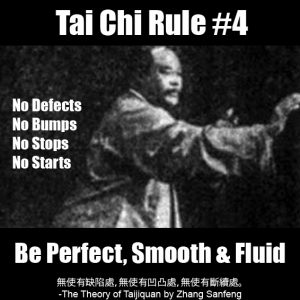No defects, no bumps, no stops and starts.
無使有缺陷處,無使有凹凸處,無使有斷續處。

No Defects
Whatever you do regularly becomes muscle memory.
If you practice Tai Chi with an error it will become a trained error that is hard to untrain.
But you can never practice 100% perfectly.
So the trick is to stay vigilant. Always include a form of error correction in your practice and seek out new ways to check for errors you may not be aware of.
Practice slowly and deliberately so that you have time to spot errors as you are making them and fix them.
Use mirrors, video, and friends to analyze and find errors.
Take time before practice to visualize what you are going to do. Take time afterwards to analyze what you did and what you need to correct.
Remember there are always errors – if you can’t find them you need to improve your skill of perception and error detection.
No bumps
Your posture should not have sharp angles, protrusions or indentations. These create weakness in your posture that limit power, cause injury, and can be exploited by an opponent.
Defects like this will also limit Qi flow. If you’re working on stirring the Qi during your set then you should feel that sensation grow stronger as you fix these defects. If you feel the sensation of Qi diminish there is likely an error in posture or tension that needs to be fixed.
This also applies to movement.
Keep in mind that there are times a movement or posture may appear to break this rule but does not.
Quick posture fix: Inflation drill
Here is one way of adhering to the “no bumps” rule. (there are others.)
Note: With each step you should breath in and out multiple times until you get a feel for the sensations being described.
1. Stand in any Tai Chi posture.
2. Breath in slowly and deeply. Relax & feel your belly expand as your diaphragm pushes it downwards to make room for the air in your lungs.
3. Pay attention to that feeling of inflation. (relaxation, pressure, and expansion combined)
4. Breath in again. This time expand that feeling of inflation to the entire torso. Belly, Chest & Back. To inflate the lower back properly you may need to bend your knees and roll your hips under you as if you are about to sit down.
5. Imagine you are a beachball. Breath in and expand the feel of inflation to your arms. Feel your shoulders, elbows, wrist and fingers gently expand.
As you inflate the upper body your posture should become bigger and rounder. The inflation should prevent any joint from having a sharp angle while at the same time preventing them from being locked out completely straight.
6. Do this again and expand the inflation to your lower body. There may be a temptation to stand up taller as you do this. Instead, bend the knees and sit down a little lower to help the feeling of expansion go outward. Side to side and front to back.
At first you will expand with the breath from a single point in the center of your body. As soon as possible, start thinking of this expansion as happening from every point simultaneously in every direction.
Take your time and focus on each joint individually. Feel it expand from it’s center in all directions. Then a do this everywhere all at once.
Move while inflated
Move through your form with this inflating quality.
You should find that this makes all your postures and moves big, smooth, and round. It prevents any sharp angles.
Remember to stay soft and relaxed. The inflation should be felt everywhere but always soft and gentle. Never forced.
This large inflated ball idea is a very important concept in Tai Chi. Though some systems will emphasize it more than others, it is always present to some degree and there are many intermediate and advanced skills that will use it in all kinds of ways.
Practicing this quality is also one way of doing “large frame” Tai Chi. A method that is most famously popularized by Yang Chen Fu, one of the first and most prolific Tai Chi teachers in the 1920’s.
Intermediate Tip
You can use this feeling of expansion without the outwardly visible expression of it.
First you must be good at feeling the inflation everywhere in a large visible way.
Then you can perform very small tight movement or awkward postures while maintaining the feeling of expansion.
This is one way you can appear to break rule 4 without actually doing so.
No stops & starts
The movement should be smooth and continuous. You can speed up and slow down if it’s done smoothly. The hard part here is that people tend to only move part of the body leaving other parts still.
The entire body should be moving at all times. Though in some areas that movement might be microscopic.